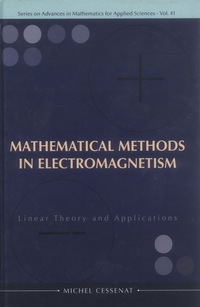Answered step by step
Verified Expert Solution
Question
1 Approved Answer
1. a.Find the Wronskian ,up to a constant, of two linearly independent solutions of the de: t^(3)y''-t^(2)(t-2)y'+(t-2)y=0 b. Determine a lower bound for the radius
1.
a.Find the Wronskian ,up to a constant, of two linearly independent solutions of the de: t^(3)y''-t^(2)(t-2)y'+(t-2)y=0
b. Determine a lower bound for the radius of convergence for the series solution about the point t_0=4 for the following DE: (25t^2+49)y''ty'+8(t-1)y=0
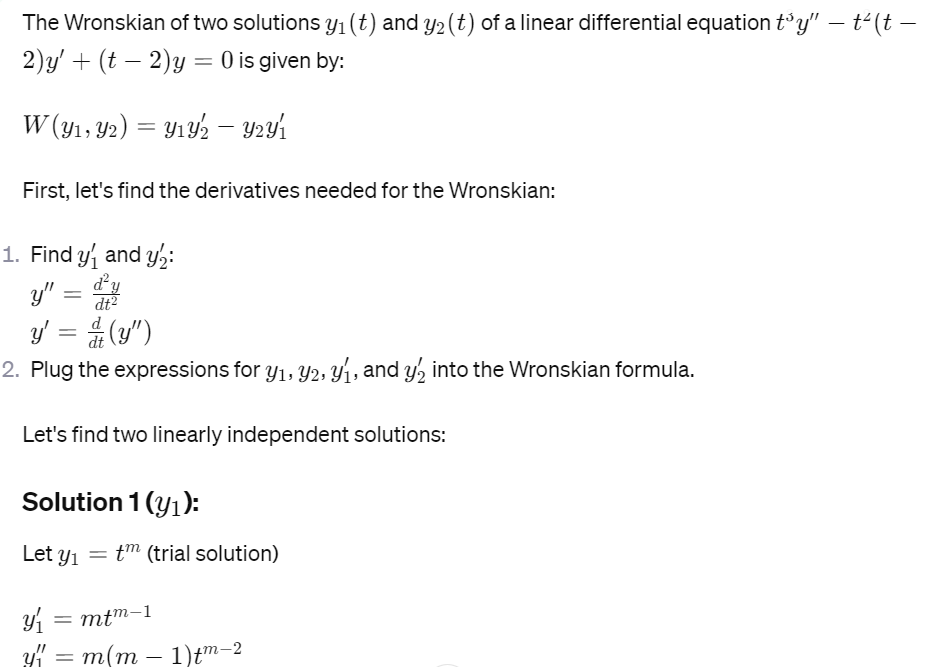
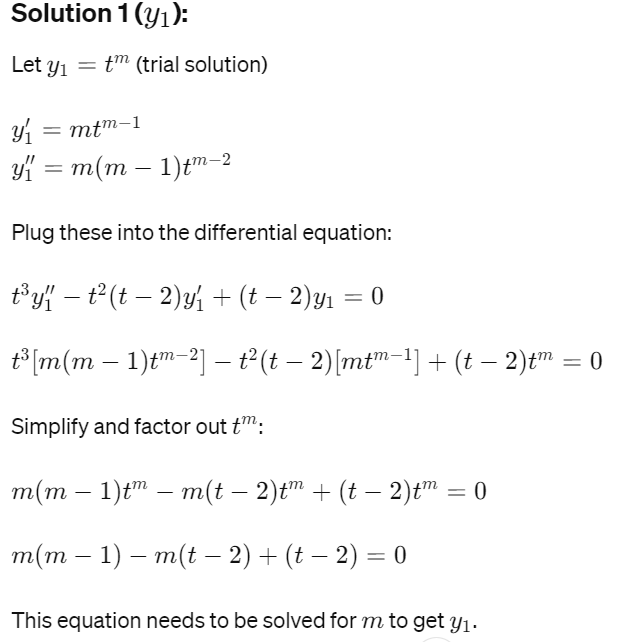
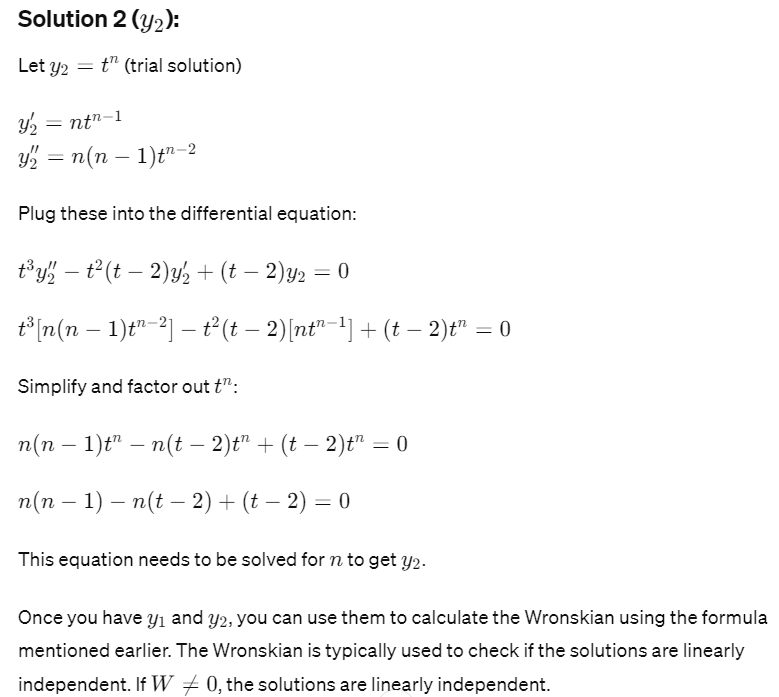

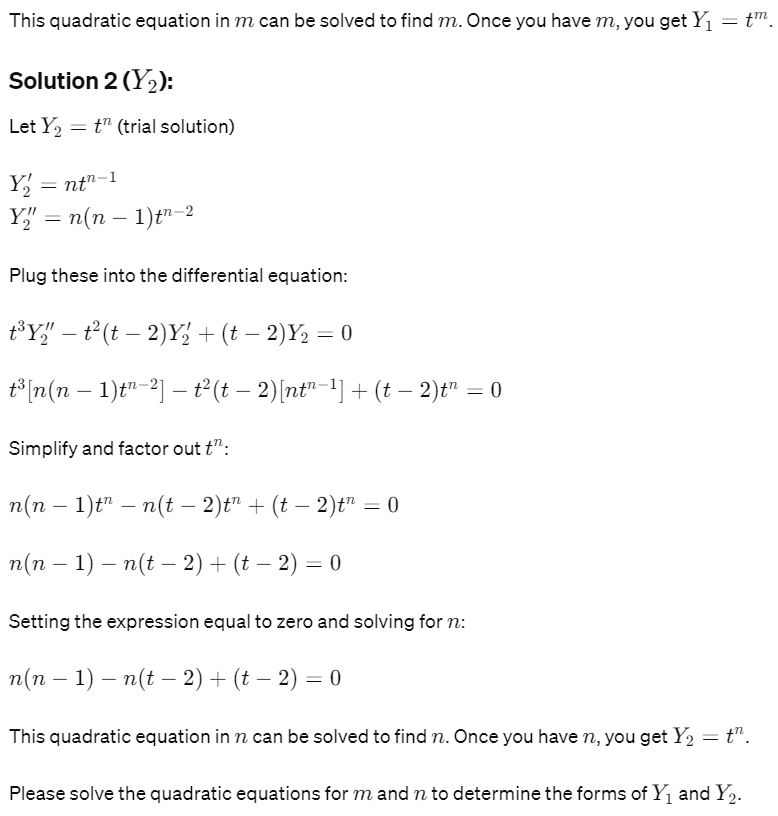 The Wronskian of two solutions y1 (t) and y2 (t) of a linear differential equation ty" - t'(t - 2)y' + (t - 2)y = 0 is given by: W (y1, y2) = y132 - yzy1 First, let's find the derivatives needed for the Wronskian: 1. Find y'; and y2: = ! dy y' = (y') 2. Plug the expressions for y1, y2, y1, and 32 into the Wronskian formula. Let's find two linearly independent solutions: Solution 1 (y1): Let y1 = t'm (trial solution) yi = mtm-1 u" = m(m - 1)+m-2Solution 1 (y1): Let y1 = t'm (trial solution) y1 = mtm-1 yi = m(m - 1)tm-2 Plug these into the differential equation: thy'' - t? (t - 2) yi + (t - 2) y1 = 0 13 [m(m - 1)tm-2] - t2(t - 2) [mtm -1] + (t - 2)tm = 0 Simplify and factor out tm. m(m - 1)tm - m(t - 2)tm + (t - 2)tm = 0 m(m - 1) - m(t - 2) + (t - 2) = 0 This equation needs to be solved for m to get y1.Solution 2 ((92): Let yg t\" (trialsolution) Plug these into the differential equation: y; rm mg + (t 2mg n t3[n(n 1)t'1 2] 32(3 2)[n.t" 1: + (t 2):\" _ 0 Simplify and factor out t\": $101 ljt\" -n(t 2)t\"l[t 2)t\"U r1[r11]n(t2) [if2) 0 This equation needs to be solved for n to get yg. Once you have 3,1 and yg, you can use them to calculate the Wronskian using the formula mentioned earlier. The Wronskian is typically used to check if the solutions are linearly independent. If W" _71 0,the solutions are linearly independent. Solution 1 ()1): Let Y1 = t' (trial solution) Yi = mtm-1 Y," = m(m - 1)tm-2 Plug these into the differential equation: +By" - t2 ( t - 2 ) Yi + (t - 2) Y1 = 0 to [m(m - 1)tm-2] - t? (t - 2) [mtm =]] + (t - 2)tm= 0 Simplify and factor out tm. m(m - 1)tm - m(t - 2)tm + (t - 2)tm = 0 m(m - 1) - m(t - 2) + (t - 2) = 0 Setting the expression equal to zero and solving for m: m(m - 1) - m(t - 2) + (t - 2) = 0 This quadratic equation in m can be solved + ind m. Once you have m, you get Y] = tm.This quadratic equation in m can be solved to find m. Once you have m, you get Y1 tm. Solution 2 (Y2): Let Y; in (trial solution) 1/; _ Hill 1 1/3! _ Tit-(- _ 1)??? 2 Plug these into the differential equation: 313\" t2(t 2)}3' + (t 2W2 _ n t3[n(n 1)t\" 2] t 2)[nt\" 1; + (t 2):n _ 0 Simplify and factor out t\": Mn ljt\" -n[t 2W1 l [t 2-)t\" 0 n[n1]n[t2](t2)U Setting the expression equal to zero and solving for 1'1: n[n1)n[t2)(t2)U This quadratic equation in n can be solved to find in. Once you have 71, you get Y2 t\". Please solve the quadratic equations for m and n to determine the forms of Y1 and Y2
The Wronskian of two solutions y1 (t) and y2 (t) of a linear differential equation ty" - t'(t - 2)y' + (t - 2)y = 0 is given by: W (y1, y2) = y132 - yzy1 First, let's find the derivatives needed for the Wronskian: 1. Find y'; and y2: = ! dy y' = (y') 2. Plug the expressions for y1, y2, y1, and 32 into the Wronskian formula. Let's find two linearly independent solutions: Solution 1 (y1): Let y1 = t'm (trial solution) yi = mtm-1 u" = m(m - 1)+m-2Solution 1 (y1): Let y1 = t'm (trial solution) y1 = mtm-1 yi = m(m - 1)tm-2 Plug these into the differential equation: thy'' - t? (t - 2) yi + (t - 2) y1 = 0 13 [m(m - 1)tm-2] - t2(t - 2) [mtm -1] + (t - 2)tm = 0 Simplify and factor out tm. m(m - 1)tm - m(t - 2)tm + (t - 2)tm = 0 m(m - 1) - m(t - 2) + (t - 2) = 0 This equation needs to be solved for m to get y1.Solution 2 ((92): Let yg t\" (trialsolution) Plug these into the differential equation: y; rm mg + (t 2mg n t3[n(n 1)t'1 2] 32(3 2)[n.t" 1: + (t 2):\" _ 0 Simplify and factor out t\": $101 ljt\" -n(t 2)t\"l[t 2)t\"U r1[r11]n(t2) [if2) 0 This equation needs to be solved for n to get yg. Once you have 3,1 and yg, you can use them to calculate the Wronskian using the formula mentioned earlier. The Wronskian is typically used to check if the solutions are linearly independent. If W" _71 0,the solutions are linearly independent. Solution 1 ()1): Let Y1 = t' (trial solution) Yi = mtm-1 Y," = m(m - 1)tm-2 Plug these into the differential equation: +By" - t2 ( t - 2 ) Yi + (t - 2) Y1 = 0 to [m(m - 1)tm-2] - t? (t - 2) [mtm =]] + (t - 2)tm= 0 Simplify and factor out tm. m(m - 1)tm - m(t - 2)tm + (t - 2)tm = 0 m(m - 1) - m(t - 2) + (t - 2) = 0 Setting the expression equal to zero and solving for m: m(m - 1) - m(t - 2) + (t - 2) = 0 This quadratic equation in m can be solved + ind m. Once you have m, you get Y] = tm.This quadratic equation in m can be solved to find m. Once you have m, you get Y1 tm. Solution 2 (Y2): Let Y; in (trial solution) 1/; _ Hill 1 1/3! _ Tit-(- _ 1)??? 2 Plug these into the differential equation: 313\" t2(t 2)}3' + (t 2W2 _ n t3[n(n 1)t\" 2] t 2)[nt\" 1; + (t 2):n _ 0 Simplify and factor out t\": Mn ljt\" -n[t 2W1 l [t 2-)t\" 0 n[n1]n[t2](t2)U Setting the expression equal to zero and solving for 1'1: n[n1)n[t2)(t2)U This quadratic equation in n can be solved to find in. Once you have 71, you get Y2 t\". Please solve the quadratic equations for m and n to determine the forms of Y1 and Y2 Step by Step Solution
There are 3 Steps involved in it
Step: 1

Get Instant Access to Expert-Tailored Solutions
See step-by-step solutions with expert insights and AI powered tools for academic success
Step: 2

Step: 3

Ace Your Homework with AI
Get the answers you need in no time with our AI-driven, step-by-step assistance
Get Started


